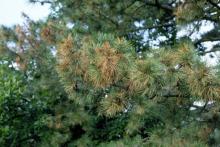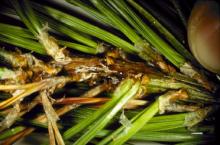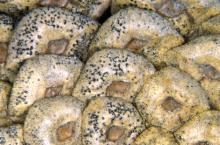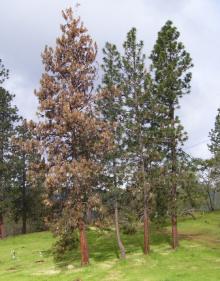Cause Diplodia sapinea (formerly Sphaeropsis sapinea), a fungus. Has become more of a problem in Idaho and Oregon on ponderosa pine. Also is a problem on Austrian, Scots, red, and mugo pine. The disease normally does not kill trees but allows other organisms (such as pine beetles) to gain entry, which may kill the tree. Generally a problem on older trees. Trees that are stressed because of poor site, drought, snow damage, or insect activity are very susceptible. For example, trees found in the transition area between high desert and foothills in central Oregon. Tree wounds are an entry for the fungus. Spores produced on infected plant debris spread to new shoots during wet spring weather. Infections may remain latent (symptomless) for many years. Under low water conditions, latent infections of red pine seedlings activate with rapid symptom development.
Symptoms Stunted, discolored needles develop on new spring growth. The shoot tip continues to die back to the main stem, killing older needles as the season progresses. Several branches or whole portions of the tree may be affected. Dead needles often remain on the branch through the next spring. Small, black fruiting bodies (pycnidia) may form in fall on twigs, needle bases, or cones.
Cultural control
- Prune out infected branches. Best to wait until dry weather in late summer so insects such as pitch moth are not attracted to pruning wounds.
- Landscape trees-keep trees well watered and stress free. Also, do not over-fertilize.
- Forest trees-thinning stands is helpful.
- Christmas trees-do not shear in wet or very humid weather.
Chemical control Apply from budbreak though shoot elongation.
- Abound at 6 to 15.5 fl oz/A for Christmas tree use. Group 11 fungicide. 4-hr reentry.
- Bravo Weather Stik at 2 to 3.5 pints/A. The disease is not on the label but the site and use times are so it is legal to use. Group M5 fungicide. 12-hr reentry.
- Concert at 22 to 35 fl oz/100 gal water. Landscape use only. Group 3 + M5 fungicide. 12-hr reentry.
- Eagle 20 EW at 6 to 12 fl oz/100 gal water is registered for a few pine species in the landscape, greenhouse and nursery. Group 3 fungicide. 24-hr reentry.
- Echo 720 at 2 to 3.5 pints/A. Group M5 fungicide. 12-hr reentry.
- Propiconazole-based products. Registered for use in field nurseries and landscapes. Group 3 fungicides.
- Banner MAXX at 5 to 8 fl oz/100 gal water. 12-hr reentry.
- ProCon-Z at 5 to 8 oz/100 gal water. 24-hr reentry.
- Propizol is registered for injection, see label for details.
- Shepherd is registered for injection at 2 to 4 ml per injection site for every 3 to 5 inches of tree circumference.
- Quadris at 6 to 15.5 fl oz/A for Christmas tree use. Do not apply more than twice sequentially. Group 11 fungicide. 4-hr reentry.
- Spectro 90 WDG at 1 to 2 lb/100 gal water. Registered for conifers grown in nursery, greenhouse or landscape. Group 1 + M5 fungicide. 12-hr reentry.
- Thiophanate-methyl-based products. Group 1 fungicide. 12-hr reentry.
- Cleary's 3336 EG at 16 to 24 oz/100 gal water. Registered for use in nurseries, greenhouse, shade or lath house, and landscapes.
- OHP 6672 4.5 F at 14.5 to 20 fl oz/100 gal water. Registered for evergreens grown in the nursery, greenhouse or landscape.
- Topsin 4.5 FL at 20 fl oz/A plus another fungicide with a different mode of action. Group 1 fungicide.
- Tourney EZ at 2 to 4 oz/100 gal water. Registered for ornamentals. Group 3 fungicide. 12-hr reentry.
References Schnepf, C.C. 1992. Diplodia Tip Blight on Ponderosa Pine, Current Information Series Publication 946. Moscow: University of Idaho Extension Service.
Stanosz, G.R., Blodgett, J.T., Smith, D.R., and Kruger, E.L. 2001. Water stress and Sphaeropsis sapinea as a latent pathogen of red pine seedlings. New Phytologist 149:531-538.






